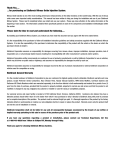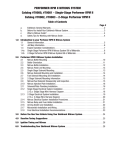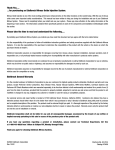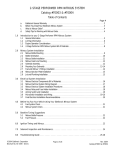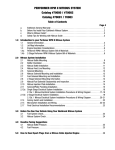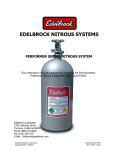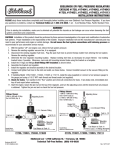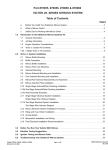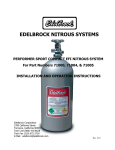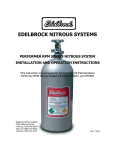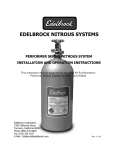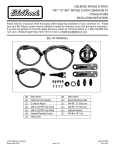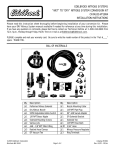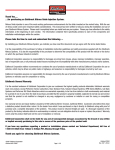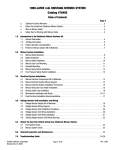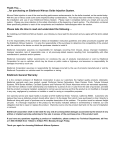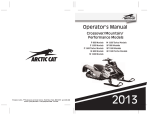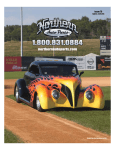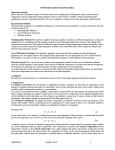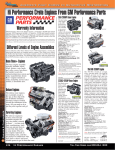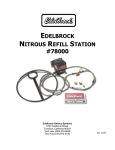Download Installation Instructions
Transcript
PERFORMER RPM SINGLE TO DUAL-STAGE UPGRADE KIT Catalog #70005 Table of Contents a. b. c. d. Page # Edelbrock General Warranty . . . . . . . . . . . . . . . . . . . . . . . . . . . . . . . . . . . . . . . . . . . . . . . . . . . . . . . . . 2 Before You Install Your Edelbrock Nitrous System . . . . . . . . . . . . . . . . . . . . . . . . . . . . . . . . . . . . . . . . . 3 What is Nitrous Oxide? . . . . . . . . . . . . . . . . . . . . . . . . . . . . . . . . . . . . . . . . . . . . . . . . . . . . . . . . . . . . . 4 Safety Tips for Working with Nitrous Oxide . . . . . . . . . . . . . . . . . . . . . . . . . . . . . . . . . . . . . . . . . . . . . . 4 1.0 Introduction to your Single to Dual Stage Upgrade Kit 1.1 General Information . . . . . . . . . . . . . . . . . . . . . . . . . . . . . . . . . . . . . . . . . . . . . . . . . . . . . . . . . . . . . . . 5 1.2 Jet Map Information . . . . . . . . . . . . . . . . . . . . . . . . . . . . . . . . . . . . . . . . . . . . . . . . . . . . . . . . . . . . . . . 6 1.3 Engine Operation Considerations . . . . . . . . . . . . . . . . . . . . . . . . . . . . . . . . . . . . . . . . . . . . . . . . . . . . . 7 1.4 Performer RPM Single to Dual Stage Upgrade Kit Bill of Materials . . . . . . . . . . . . . . . . . . . . . . . . . . . . 8 2.0 Nitrous System Installation 2.1 Installation Instructions . . . . . . . . . . . . . . . . . . . . . . . . . . . . . . . . . . . . . . . . . . . . . . . . . . . . . . . . . . . . . 9 2.2 2-Stage Electrical System Bill of Materials . . . . . . . . . . . . . . . . . . . . . . . . . . . . . . . . . . . . . . . . . . . . . 10 2.3 2-Stage Wire Harness Diagram. . . . . . . . . . . . . . . . . . . . . . . . . . . . . . . . . . . . . . . . . . . . . . . . . . . . . . 11 2.4 2-Stage Nitrous Electrical System Installation Procedure . . . . . . . . . . . . . . . . . . . . . . . . . . . . . . . . . . 12 3.0 Before You Run Your Vehicle Using Your Edelbrock Nitrous System 3.1 Fuel System Check . . . . . . . . . . . . . . . . . . . . . . . . . . . . . . . . . . . . . . . . . . . . . . . . . . . . . . . . . . . . . . . 13 3.2 Nitrous System Check. . . . . . . . . . . . . . . . . . . . . . . . . . . . . . . . . . . . . . . . . . . . . . . . . . . . . . . . . . . . . 13 4.0 Baseline Tuning Suggestions . . . . . . . . . . . . . . . . . . . . . . . . . . . . . . . . . . . . . . . . . . . . . . . . . . . . . . . . . . 14 5.0 Ignition Timing and Nitrous . . . . . . . . . . . . . . . . . . . . . . . . . . . . . . . . . . . . . . . . . . . . . . . . . . . . . . . . . . . 15 6.0 Solenoid Inspection and Maintenance . . . . . . . . . . . . . . . . . . . . . . . . . . . . . . . . . . . . . . . . . . . . . . . . . . 16 7.0 Troubleshooting Guide . . . . . . . . . . . . . . . . . . . . . . . . . . . . . . . . . . . . . . . . . . . . . . . . . . . . . . . 17 Catalog #70005 Rev. 07/08 - AJ/mc Page 1 of 20 ©2008 Edelbrock Corporation Brochure No. 63-70005 Performer RPM Single to Dual Stage Upgrade Kit Catalog #70005 Thank You…. …for purchasing an Edelbrock Nitrous Oxide Injection System. Nitrous Oxide injection is one of the most exciting performance enhancements, for the dollar invested, on the market today. With the use of nitrous oxide come some important safety considerations. This manual has been written to help you during the installation and use of your Edelbrock Nitrous System. Please read it completely before you install and use your system. Please pay close attention to the safety information at the beginning of each section. The information contained there specifically pertains to each of the components and installation methodologies within the section. Please take the time to read and understand the following…. By installing your Edelbrock Nitrous System, you indicate you have read this document and you agree with the terms stated below: It is the responsibility of the purchaser to follow all installation instruction guidelines and safety procedures supplied with the Edelbrock Nitrous Systems. It is also the responsibility of the purchaser to determine the compatibility of the product with the vehicle or the device on which the purchaser intends to install it. Edelbrock Corporation assumes no responsibility for damages occurring from misuse, abuse, improper installation, improper operation, lack of responsible care, or all previously-stated reasons resulting from incompatibility with other manufacturer’s products and/or systems. Edelbrock Corporation neither recommends nor condones the use of products manufactured or sold by Edelbrock Corporation for use on vehicles, which may be driven on public roads or highways, and assumes no responsibility for damages incurred by such use. Edelbrock Corporation assumes no responsibility for damages incurred by the use of products manufactured or sold by Edelbrock Corporation on vehicles used for competition or racing. Edelbrock General Warranty It is the constant endeavor of Edelbrock Corporation to give our customers the highest quality products obtainable. Edelbrock warrants each new product, except Performer Series Carburetors, Race Division Parts, Tubular Exhaust Systems, RPM Series Mufflers, Cat-Back Systems and Performer IAS Shock Absorbers which are warranted separately, to be free from defects in both workmanship and material for a period of one (1) year from the date of purchase, provided that the product is properly installed, subjected to normal use and service and that the product is not modified or changed in any way, negligence by customer or installer or used for racing or competition purposes. Our warranty service and repair facility is located at 2700 California Street, Torrance, California 90503. Customers who believe they have a defective product should either return it to the dealer from which it was purchased or ship it directly to Edelbrock along with proof of purchase and a complete description of the problem. The product must be returned freight pre-paid. If a thorough inspection of the product by the factory indicates defects in workmanship or material, our sole obligation shall be to repair or replace the product. Warranty covers only the product itself and not the cost of installation or removal. Edelbrock Corporation shall not be liable for any and all consequential damages occasioned by the breach of any written or implied warranty pertaining to this sale in excess of the purchase price of the product sold. If you have any questions regarding a product or installation, please contact our Technical Department, toll free at 1-800-416-8628 from 7:00am to 5:00pm PST, Monday through Friday. Thank you again for choosing Edelbrock Nitrous Systems. Catalog #70005 Rev. 07/08 - AJ/mc Page 2 of 20 ©2008 Edelbrock Corporation Brochure No. 63-70005 Caution!! Before You Install Your Edelbrock Nitrous System… Please read this Installation manual fully before installing this system. You will need to have available the following tools: Hand Tools: ❑ Socket set including ratchets and extensions ❑ Screwdrivers ❑ Pliers ❑ Bench vise ❑ Wire crimping pliers, wire strippers ❑ Floor jack ❑ Measuring tape and placement markers ❑ Vehicle jackstands ❑ Safety glasses ❑ Timing light Power Tools: ❑ Power drill ❑ Drill bits You should understand the following skills: ❑ Power tool safety procedures ❑ Undercar safety procedures ❑ Proper measuring techniques ❑ Proper electrical assembly techniques ❑ Basic engine operation and tuning techniques which include: -Fuel pressure measurement techniques -Timing adjustment techniques ℡ Catalog #70005 Rev. 07/08 - AJ/mc Anytime you have questions or concerns with your Edelbrock Nitrous System, please call our Technical Support Hotline at 1-800-416-8628 before you start your engine. Page 3 of 20 ©2008 Edelbrock Corporation Brochure No. 63-70005 WHAT IS NITROUS OXIDE? Nitrous Oxide is a cryogenic gas composed of nitrogen and oxygen molecules. It is stored as a “gas over a liquid” which means that both liquid and gaseous nitrous oxide is delivered into your engine. It is 36% oxygen by weight, which is what produces the added horsepower. By injecting more oxygen (and a corresponding fuel signal), we create the additional power much like a supercharger or a turbocharger does. Nitrous Oxide is considered an “oxidizer” and not a fuel. Nitrous oxide is non-flammable by itself. Because nitrous oxide is a cryogenic, the same safety methods in handling dry ice apply to nitrous. Direct contact with the skin will cause a burn similar to contact with dry ice. The exception in using nitrous oxide comes from increased breathing hazards associated with the gaseous properties of nitrous oxide. Nitrous Oxide is offered for sale in two common grades, which are U.S.P., and Nytrous Plus. U.S.P. nitrous oxide is medical grade nitrous oxide. Its common use is dental and veterinary anesthesia as well as use as a propellant in food such as canned whip cream. U.S.P. is not available to the public and would provide no advantage in the making of horsepower over the automotive grade nitrous oxide. Nytrous Plus was specifically designed for automotive consumption and differs from U.S.P. in that it contains trace amounts of sulfur dioxide (100 parts per million or “PPM”) added to prevent substance abuse. The Sulfur Dioxide is an irritant to all of your breathing passageways and will cause sore throats and sore nasal passages. Nytrous Plus was specifically created for automotive applications and is available for sale to the public at many speed shops across the USA. Safety Steps For Working With Nitrous Oxide 1. Never inhale Nytrous Plus (Nitrous oxide (N2O) for vehicular use) as continued exposure can cause death. Nytrous Plus has a maximum of 100 parts per million (ppm) of sulfur dioxide and will cause irritation to nose and throat passageways. 2. When working around any high-pressure gas including nitrous oxide, take all precautions to ensure that exposure to nitrous oxide is minimized. 3. Do not vent nitrous oxide to atmosphere in confined spaces. Only vent nitrous oxide in well-ventilated and open areas. 4. Liquid nitrous oxide can cause burns to human flesh so protect all skin in and around your hands, arms and face. Wear safety glasses and rubber gloves to protect from liquid nitrous oxide splatter. 5. When venting down the nitrous system, vent the line down closest to the nitrous bottle. 6. Do not use any form of Teflon tape as sealant on fitting connections. Use only Teflon paste. 7. When washing components, ensure the clean components are completely dry, free of oils, and solvents. Failure to remove all liquids could cause component or system failure. 8. Always turn the bottle off before making any repairs to the nitrous delivery system. 9. To safely release nitrous oxide in a pressurized line; a. Position vehicle in a well-ventilated, unconfined space. b. Turn bottle off. c. Slowly loosen the nitrous feed line at the bottle until you hear a light hissing noise. d. Allow the entire nitrous pressure to vent from the line. e. Perform your work on the system. f. Tighten the nitrous line to the bottle. g. Slowly open the nitrous bottle valve, listening for leaks. h. Perform leak checks on all affected fittings and the bottle fitting. Catalog #70005 Rev. 07/08 - AJ/mc Page 4 of 20 ©2008 Edelbrock Corporation Brochure No. 63-70005 1.0 Introduction to your Edelbrock Single to Dual Stage Upgrade Kit Within the pages of this manual is information, safety tips and operation instructions for your new Edelbrock Nitrous System. Watch for these symbols to know where to go for information. ….There is safety related information here. installation. ℡ ….call Edelbrock Technical support hotline for more information. ….shows where technical information about your vehicle or specific skills that may help during 1.1 General Information The Edelbrock Performer RPM Single to Dual Stage Upgrade Kit (Part Number 70005) is intended for use on domestic style V-8 engines using single square-flange 4 bbl. carburetors and Spread-bore 4 bbl. carburetors. Horsepower and torque increases can vary with equipment upgrades and modifications. These types of systems utilize an adjustable plate that seats in between the carburetor and the carburetor mounting flange on the intake manifold. The adjustability comes from the ability of the plate to accept different orifice-sized jets. The plate has y-shaped jet fittings at opposite ends of the plate that control the amount of nitrous oxide and fuel flow into the engine. This system has been designed with some flexibility as to where certain components can be located to allow easy installation on vehicles with upgraded or modified equipment. The solenoid and microswitch brackets are designed to be manipulated (bent, cut, twisted, etc.) and the electrical components have properly sized and ample lengths of wire. Contact your local automotive store, motorcycle shop or race track for refilling of your bottle. Trust a professional to properly fill your bottle and reference your installation manual when re-installing your filled bottle back into your vehicle. Always take care when handling a full bottle of nitrous oxide. Please reference this manual for further safety measures to take during the handling of a nitrous oxide bottle. Please follow all safety methods during the installation of your Edelbrock Nitrous System, and follow all vehicle regulations and road laws when using your nitrous system. Catalog #70005 Rev. 07/08 - AJ/mc Page 5 of 20 ©2008 Edelbrock Corporation Brochure No. 63-70005 1.2 Jet Map Information Edelbrock engineering has conducted dyno testing with the Performer RPM II system to provide you with a baseline jet map. Your jet map may change with the use of other components. These jet combinations are supplied with this system to enable you to vary your engine’s power output. Square Flange Jet Map 1st Stage Jet and Timing Map 2nd Stage Jet Map Initial HP Nitrous Fuel 1st Stage Timing Additional Nitrous Fuel Gain Jet Jet Adjustment HP Gain Jet Jet 75 46 46 1°-3° Retard 75 46 46 100 57 57 3°-5° Retard 100 57 57 125 64 64 4°-6° Retard 125 64 64 Total HP Gain 150 200 250 Dual Stage Timing Map Total Timing Footnotes Adjustment 5°-7° retard 1, 3 7°-9° retard 2, 4, 5, 6 9°-11° retard 2, 4, 5, 6 Total HP Gain 100 200 250 Dual Stage Timing Map Total Timing Footnotes Adjustment 3°-5° retard 1, 3 7°-9° retard 2, 4, 5, 6 9°-11° retard 2, 4, 5, 6 Dominator Jet Map 1st Stage Jet and Timing Map 2nd Stage Jet Map Initial HP Nitrous Fuel 1st Stage Timing Additional Nitrous Fuel Gain Jet Jet Adjustment HP Gain Jet Jet 50 38 38 0°-2° Retard 50 38 38 100 57 57 1°-3° Retard 100 57 57 125 64 64 4°-6° Retard 125 64 64 Jet Map Footnotes: 1. 2. 3. 4. 5. 6. Use 1 heatrange colder spark plugs Use 2 heatrange colder spark plugs Use 92 octane pump gasoline or better Use 110 octane race gasoline or better Use a single plane manifold only at this power level Advanced tuning required. Suggested timing adjustment is just a guideline. Engine component modifications may affect final timing set point. Edelbrock recommends an NGK spark plug with a heat range of -9 to -11 depending on the nitrous power level being tuned. When in doubt, always go to the next cooler heat range plug. The dyno tests were conducted at Edelbrock using a highly modified Big Block Chevrolet. Modifications included Edelbrock intake manifold, cylinder heads, dyno headers, pistons, rods, crankshaft, and improved ignition. These tests were conducted with 950 psi nitrous and 6.5 psi fuel pressure. All stated timing adjustments listed in the jet map is where the motor being tested performed best. Final timing should be adjusted to achieve best power and/or MPH per application. See section “5.0 Ignition Timing and Nitrous” for more information on timing selection. Any variation in jetting patterns other than what is listed above and engine damage could occur. Please contact the Edelbrock Technical Department with any questions you have concerning jetting patterns and their effects on engine performance. Catalog #70005 Rev. 07/08 - AJ/mc Page 6 of 20 ©2008 Edelbrock Corporation Brochure No. 63-70005 1.3 Engine Operation Considerations When used correctly, nitrous oxide safely elevates cylinder pressures and temperatures while increasing combustion rate. These characteristics make the engine more sensitive to detonation. To ensure proper performance and engine life, the following tips are suggested: Adequate Fuel Pressure and Delivery: When designing your fuel system, plan on your pumps and lines flowing at least 0.1 gallons per hour per horsepower at rated pressure. The testing at Edelbrock was conducted with a fuel pressure of 6 to 6.5 psi. Any variation from this fuel pressure will cause your final air/fuel ratio to change. Consult our technical department for any questions on fuel pressure and its effects on final air/fuel ratios when using nitrous oxide. Edelbrock recommends setting your fuel pressure flowing. We offer a flow tool (Edelbrock Part #76506) to help in this process. Performer RPM Fuel System Requirements: When using the Performer RPM series kits, the potential horsepower gains are quite high. The critical area for continued success with your nitrous system lies in the fuel system. In most cases, an auxiliary fuel supply system will be a required addition to your nitrous system. A high flow electric fuel pump and high capacity adjustable fuel pressure regulator are both recommended to ensure the fuel flow rate is enough to ensure proper system operation. The minimum size we recommend for the fuel inlet feed line is a –6 (3/8” inch), with a size of –8 (1/2” inch) recommended for the higher horsepower settings. Performer RPM System Monitoring Requirements: Fuel pressure and nitrous pressure gauges are very important. Your fuel pressure must be set properly and a gauge is the only sure way to monitor system performance. The same is true of the nitrous bottle pressure. A nitrous pressure gauge is the only way to ensure that your system calibrations are within the parameters required of your horsepower setting. Fuel Quality: Because nitrous oxide is an oxidizer, fuel selection is critical. Both octane and fuel consistency affect fuel burn rate. The oxidizer quality of nitrous oxide will accelerate the burn rate, so we recommend a high quality of gasoline. We also recommend you use the same grade of gasoline every time you use your nitrous oxide system. This will maintain the same fuel burn rate every time. Please refer to the jet map footnotes for information on what fuel types and fuel qualities that were used during the testing here at Edelbrock. Engine System Upgrades: With all performance modifications complementary system upgrades will always serve to elevate the consistency and longevity of an engine, especially when using nitrous oxide as a power adder. Ignition upgrades, intake manifold upgrades, and fuel controls and fuel pumps can all add to the performance of a nitrous oxide injected engine. Cast Pistons/Hypereutectic Pistons: With all nitrous oxide applications, forged pistons are highly recommended. Because of heightened potential for detonation, cast pistons and hypereutectic pistons are more prone to failure and cannot handle horsepower increases over 125 hp. Never initiate your nitrous system before you are at full-load, wide-open throttle conditions. Cast pistons will not be able to survive this kind of stress. Catalog #70005 Rev. 07/08 - AJ/mc Page 7 of 20 ©2008 Edelbrock Corporation Brochure No. 63-70005 1.4 Performer RPM Single to Dual Stage Upgrade Kit Bill of Materials Qty. Description 1 ea. 1 ea 2 ea. Solenoids and Solenoid Hardware Performer Nitrous Solenoid Performer Fuel Solenoid Performer Solenoid Brackets w/ Screws 1 ea 1 ea 2 ea 1 ea 1 ea 1 ea 1 ea Fittings 4AN x 1/8”NPT Filter Fitting, Blue 4AN x 1/8”NPT Fitting, Blue 4AN x 1/8”NPT Fitting, Red Y-Fitting Jet Adapter, Blue Y-Fitting Jet Adapter, Red 4AN Y-Fitting, Blue 4AN Y-Fitting, Red Catalog #70005 Rev. 07/08 - AJ/mc Qty. Description 2 ea 2 ea 1 ea 1 ea Hoses 4AN 12” Steel Braided Hose, Blue 4AN 12” Steel Braided Hose, Red 4AN to 3AN 12” Steel Braided Hose, Blue 4AN to 3AN 8” Steel Braided Hose, Red Misc Various Included Jets Page 8 of 20 ©2008 Edelbrock Corporation Brochure No. 63-70005 2.0 Nitrous System Installation 2.1 Installation Instructions 1. Disconnect both the nitrous and fuel lines leading from the solenoids to the plate. Be careful not to lose the nitrous and fuel jet that you currently have installed in the system when removing these lines. 2. Using a 7/16” wrench or socket remove both the nitrous inlet fitting and the fuel inlet fitting. 3. Thoroughly clean the threaded holes of the plate that are exposed after removal of the inlet fittings. Make sure that there is no metal debris in these holes and that they are free of thread sealant or locking compound. Make sure that no debris falls into the nitrous or fuel spray bars. After cleaning the area, use a shop vacuum or other vacuum to suction any remaining debris from the inlet areas. 4. Place a small bead of Teflon Paste, NOT TEFLON TAPE, around the thread of each of the supplied Y-Fittings. 5. Carefully thread the new Y-Fittings into the inlet ports of the plate. Make sure that the blue Y-Fitting gets installed in the port labeled ‘Nitrous’ and the red Y-Fitting gets installed in the port labeled ‘Fuel’. Using a 7/16” wrench, tighten these fitting into the plate while being careful not to over-tighten and strip the threads out of the plate. The Teflon Paste should form a nice bead completely around the port to help ensure a good seal. 6. Place a small bead of Teflon Paste around the threads on the blue 4AN to 1/8”NPT fitting supplied in the kit. Thread this fitting into the OUTLET port of the supplied Performer Nitrous Solenoid. 7. Place a small bead of Teflon Paste around the threads on the blue 4AN to 1/8”NPT filter fitting supplied in this kit. Thread this fitting into the INLET port of the supplied Performer Nitrous Solenoid. 8. Secure the Performer Nitrous Solenoid in a bench vise and tighten both the inlet and outlet fittings being careful not to overtighten and strip the threads. 9. Place a small bead of Teflon Paste around the threads on the red 4AN to 1/8”NPT fitting supplied in this kit. Thread this fitting into the OUTLET port of the supplied Performer Fuel Solenoid. 10. Place a small bead of Teflon Paste around the threads on the red 4AN to 1/8”NPT fitting supplied in this kit. Thread this fitting into the INLET port of the supplied Performer Fuel Solenoid. 11. Secure the Performer Fuel Solenoid in a bench vise and tighten both the inlet and outlet fittings being careful not to over tighten and strip the threads. 12. Using the supplied solenoid brackets and solenoid mounting screws, mount the solenoids within reach of the jet fittings on the plate using the supplied blue 4AN to 3AN 12” hose for nitrous and red 4AN to 3AN 8” hose for fuel. 13. Choose your intended horsepower settings from the jetting chart on page 6. Find the first stage jetting that you intend to run in the supplied jet bag that comes with this kit. Use the jets supplied in the jet pack for your Performer RPM Nitrous System for the second stage jets. 14. Place the first stage nitrous jet in one of the inlet ports of the blue nitrous Y-Fitting of the plate closest to the Performer Nitrous Solenoid. Install one of the 12” Blue 3AN to 4AN lines from the outlet fitting of the Performer Nitrous Solenoid to the fitting containing the first stage nitrous jet. Snug down both ends of this line but do not over tighten to prevent stripping. 15. Place the first stage fuel jet in one of the inlet ports of the red fuel Y-Fitting of the plate closest to the Performer Fuel Solenoid. Install one of the 8” Red 3AN to 4AN lines from the outlet fitting of the Performer Fuel Solenoid to the fitting containing the first stage fuel jet. Snug down both ends of this line but do not over tighten to prevent stripping. 16. Place the second stage nitrous jet in the remaining open inlet fitting of the blue nitrous Y-Fitting. Install the line as described in step 14 but to the Performer RPM Nitrous Solenoid. 17. Place the second stage fuel jet in the remaining open inlet fitting of the red fuel Y-Fitting. Install the line as described in step 15 but to the Performer RPM Fuel Solenoid. 18. Using the two red 4AN fuel lines and red 4AN Y-Fitting supplied with this kit, connect each solenoid to the Y-Fitting. 19. Connect the fuel line that was originally connected to your Performer RPM Solenoid to the inlet of the red 4AN Y-Fitting. 20. Repeat steps 18 and 19 using the blue lines and Blue Y Fitting for the nitrous solenoids. 21. Wire per the diagram on page 11. Catalog #70005 Rev. 07/08 - AJ/mc Page 9 of 20 ©2008 Edelbrock Corporation Brochure No. 63-70005 The picture at right shows a typical solenoid installation. 2.2 2-Stage Electrical Components Bill of Materials (BOM) Quantity 1 ea. 1 ea. 2 ea. 2 ea. 1 ea. 1 ea. 1 ea. 6 ea. 2 ea. 2 ea. 3 ea. 5 ea. 1 ea. 1 ea. 1 ea. 1 ea. 1 ea. 2 ea. Description Activation microswitch Activation microswitch bracket (not shown) Activation microswitch mounting nut Activation microswitch mounting screw 30 amp relay Wire harness with integral relay/fuse holders Red lighted toggle switch 18/22g female spade connector, Nylon insulated 14/16g female spade connector, Nylon insulated 14-16g male spade connector, Nylon insulated 16/18, splice connector 14/16g 3/8” ring terminal, Nylon insulated Male blade fuse tap 14/16g male spade connector, Nylon insulated Nitrous 2nd stage push button 30 amp ATO blade fuse 15 amp ATO blade fuse 18/22g female spade connector, Nylon insulated Nomenclature Descriptions: ATO… the fuse configuration is ATO. When replacing this fuse, ask for an ATO fuse. “a”… Amperage. Important: The wiring hardware and instructions included with this kit are intended for 12-volt electrical systems only. Before attempting to wire your Edelbrock Performer nitrous oxide system, examine and follow the wiring diagram on the following page. Please call the Edelbrock Technical department with any questions concerning electrical wiring. When working with electrical systems in your vehicle, it is a good idea to have a service manual that features your vehicle. It is also good practice to have a book that specializes on the specialized techniques required when working with vehicular electrical systems. Catalog #70005 Rev. 07/08 - AJ/mc Page 10 of 20 ©2008 Edelbrock Corporation Brochure No. 63-70005 2.3 2-Stage Nitrous Electrical System Wiring Diagram FUSE HOLDER 2nd STAGE RELAY RED 1st STAGE RELAY RED BLUE WHITE WHITE BLACK BATTERY BLACK SWITCHED +12V BLUE GROUND MICRO SWITCH 2nd STAGE SOLENOID 2nd STAGE SOLENOID 1st STAGE SOLENOID 1st STAGE SOLENOID BLACK GROUND PUSHBUTTON GROUND GROUND Wire Schematic Origin and Destination Map Catalog #70005 Rev. 07/08 - AJ/mc Page 11 of 20 ©2008 Edelbrock Corporation Brochure No. 63-70005 2.4 2-Stage Nitrous Electrical System Installation Procedures Determine the location of the relay and fuse holder wire harness. Most common installations locate these components inside the driver’s compartment and close to the fuse panel under the dash. You can also mount the relay and ruse holder harness close to the battery. However, these connectors are water-resistant not waterproof, so care is required when mounting this assembly under the hood of your vehicle. The wire harness attached to the relay and fuse holder includes 8 feet of color-coded wires to make the electrical system installation for your Edelbrock Nitrous System as easy as possible. We recommend not cutting any lengths of wires from the wire harness or complete the wiring of the nitrous system until all of the mechanical components are securely mounted in their permanent locations. Once all of the solenoids and switches are placed, route the un-cut wires from the harness to each location allowing enough wire length on each circuit to not interfere with operating linkages, heat sources, brackets, etc. Pay particular attention to sharp edges along the route of your wire harness to prevent wire damage. After you have accounted for the routing of your wires, follow the Wire Harness Schematic on page 17 and use the Origin and Destination Map as a guide for which electrical connectors are used in each circuit. Once you have decided the location of the relay and fuse holder, secure them with fasteners (not included with kit) such as sheet metal screws, bolts and nuts, etc. Allow for some slack in the red wire that connects the relay and fuse holders together. When mounting your relay and fuse holder, make sure the mounting surface is strong enough to support servicing the relay and fuse. Also, ensure you allow for some slack in the wire that joins the fuse holder to the relay mount. This will avoid any potential loss of power due to stress on the wire harness. The fuse is covered by the fuse mount housing. The relay's for the Performer RPM system are rated for 30 amps, and the fuses are 15 amps for each stage or one 30 amp for both stages. Catalog #70005 Rev. 07/08 - AJ/mc Page 12 of 20 ©2008 Edelbrock Corporation Brochure No. 63-70005 3.0 Before You Run Your Vehicle Using Your Edelbrock Nitrous System You have just completed the installation of your Edelbrock Nitrous System. It is time to perform some basic system checks to ensure all of the work you have done is correct and ready to operate properly. The following procedure is designed to validate the operation of your nitrous system before operating your vehicle: Note: Before performing steps 1 through 4, make sure that the nitrous bottle is closed and main nitrous supply line is empty of any nitrous. 3.1 Fuel System Check 1. 2. 3. 4. 5. 3.2 Hook up all battery leads. Double-check all wires and leads for signs of heat and proper connections. Start your vehicle. Check all fuel lines and fittings for leaks. Switch master arming switch to the “on” position (switch should now glow red). Make sure the nitrous bottle is closed and the main feed line are completely empty of ANY nitrous! Raise the engine speed to above 2000 RPM. Briefly depress the activation arm on microswitch, which will open the fuel and nitrous solenoids. Listen for a loud click or hold the solenoids while you active the microswitch. Engine speed should decrease if the fuel solenoid and delivery system are performering properly. If not, refer to “Trouble Shooting Guide”. Nitrous System Check 1. 2. 3. 4. Catalog #70005 Rev. 07/08 - AJ/mc With the vehicle's engine running, slowly open nitrous bottle valve. Note: There should be no change in engine idle speed. If idle speed changes, close nitrous bottle valve immediately and refer to the "Troubleshooting Guide" section. Inspect nitrous lines and fittings for leaks using a soapy water mixture and a small brush. If any of the fittings/connections show bubbling around the attachment nut or on the threaded area of the fitting, shut the nitrous bottle valve off immediately and dry the fitting before attempting any service to that particular fitting connection. If the engine idle does not come up, and all of the fittings appear to be leak-free, you have successfully completed the installation of you Edelbrock Nitrous System. Page 13 of 20 ©2008 Edelbrock Corporation Brochure No. 63-70005 4.0 Baseline Tuning Suggestions Utilizing nitrous oxide as a power adder is similar to a supercharger or a turbocharger in that it increases the amount of air an engine can get over a naturally aspirated condition. There are some significant differences: 1. Nitrous oxide is very oxygen rich. This oxygen is of a much higher density, so the opportunity to extract very high quotients of power is high. 2. Nitrous oxide injection does not have a parasitic load factor associated with its use and as such does not cost horsepower in the manner of a crank-driven supercharger or an exhaust-driven turbocharger. The most important thing to remember when looking at baseline tuning issues associated with nitrous oxide is that a lean condition is bad. Two parameters that will keep you from catastrophically affecting your engine are: Nitrous Bottle Pressure...Always keep your bottle pressure between 900 and 950 psi. Yes, there are racers that use different pressures, but the testing we did here at Edelbrock to ensure the jetting maps within this manual are correct, was done in this pressure range. Use any higher pressure than 950 psi and you will be lean. Use any pressures below 900 psi and you will be rich. Fuel Pressure...Always ensure you have between 6-6.5 psi of fuel pressure every time you enable your nitrous system. We used 6 to 6.5 psi of fuel pressure to perform our jet map testing on this system. If you do not have at least 6psi of fuel pressure going to the fuel solenoid, when it is activated, you will be encountering a lean condition. If you were to have more than 6.5 psi of fuel pressure, when it is activated, to the fuel solenoid, you would have a rich condition. There are many different ways to jet to a specific power level. However, for the continued safe operation of your nitrous system, we suggest you do not move too far away from the jet map listed within this manual. Catastrophic engine failure could result. Your 2-Stage Performer RPM nitrous system comes with matched sets of nitrous and fuel jets. These are validated jetting combinations, based upon 900 to 950 psi nitrous oxide bottle pressure, and 6 to 6.5 psi flowing fuel pressure. Operating with these pressure levels should yield safe and reliable power increases. Spark Plug Facts The most important aspects to be considered when selecting a Spark Plug for your nitrous combination are, but not limited to: heat range, firing end design, material construction type, reach, thread size, and gap. We advise lowering the heat range of your spark plugs 1 to 2 steps for every 100 hp added with nitrous. We do not recommend the use of Precious metal type plugs i.e.: Platinum, Iridium, Gold Palladium, or Yttrium. The tips on these types of plugs can get very hot and cause detonation. It is best to use a non projected tip plug without a fine wire center electrode designed for a gap between .025" and .035" with a shorter preferably thicker ground strap. Never try to gap a plug designed for a .060" gap down to.035". Edelbrock suggest an NGK spark plug with a heat range of -9 to -11 depending on the nitrous power level being tuned. When in doubt, always go to the next cooler heat range plug. How to Read Spark Plugs From a Nitrous Oxide Injected Engine... Spark plugs are a window into the combustion chamber. They will tell you many things about the operation of the vehicle. Here are some tips on looking at spark plugs to “read” what is happening with your engine: Correct timing, mixture and spark plug heat range Ground strap retains “like new” appearance. Edges are crisp, with no signs of discoloration. Porcelain retains clear white appearance with no “peppering” or spotting. Excessively rich mixture Porcelain may be fuel-stained, appearing brown or black. In extreme cases, ground strap, electrode and porcelain may be damp with gasoline, or smell of fuel. Detonation Edges of ground strap may become rounded. Porcelain has the appearance of being sprinkled with pepper, or may have aluminum speckles. During heavy detonation, the ground strap tip may burn off. This phenomena can result from excessive ignition timing, too high a heat range spark plug, or inadequate fuel octane. Excessively lean mixture Edges of ground strap may become rounded, or broken. (Under moderate overheating, the tip of the ground strap can discolor, usually turning purple, or the entire ground strap can become discolored.) Catalog #70005 Rev. 07/08 - AJ/mc Page 14 of 20 ©2008 Edelbrock Corporation Brochure No. 63-70005 5.0 Ignition Timing and Nitrous Because we are oxidizing the air/fuel mix going into the engine when nitrous oxide is used, we must pay close attention to the ignition timing profile. Remember, “nitrous” oxygen is more dense than “atmospheric” oxygen and resulting in an accelerated burn rate of your fuel. In anticipation of the quicker burn time, you must retard the timing of the ignition system when using nitrous oxide. The more power we try to make, the more timing in degrees we must remove from the timing profile. This is not in total advance but the time in which we bring timing in (the advance curve). This is why all nitrous users are so concerned with evidence of detonation. The accelerated burn rate of the air/fuel charge can cause severe detonation without a “nitrous” ignition strategy. A timing profile that is accelerated and a total timing number retarded will keep you from experiencing catastrophic engine damage. The general rule of nitrous use ignition timing should be to retard the “total” advance number approximately 2 degrees for every 50 HP increase when using nitrous oxide. It is always best to start with your engines best total timing (without nitrous) and reduce total timing from there. Use an initial timing retard setting that is at least 2-4 degrees more retarded than you expect to be the best setting for your application. All stated timing adjustments listed in jet maps is where the motor being tested worked best. Every aspect of the vehicle and engine affects your nitrous systems performance-- vehicle weight, converter, gearing, engine displacement, cylinder head type, camshaft, compression, manifold and induction type ect.. The exact amount of timing to pull out varies for every combination. Start conservatively, and put timing back in gradually. On a Nitrous system, even 1 degree change in advance can make a big difference. When using aftermarket ignition components and/or systems, it would be advisable to contact the manufacturer for information on using their components with a nitrous system. It is always better to be very conservative in your timing approach and tune towards an optimum timing setting. Example: Ignition timing without Nitrous Oxide 100 HP increase from Nitrous Oxide Initial safety margin Total timing with Nitrous Oxide 38 degrees “total” 2 degrees “retard” 2 degrees “retard” 34 degrees “total” The following test plan, for determining ignition timing, will give you a guide to determine the best timing profile for your vehicle, hopefully avoiding engine damage during the tuning phase: 1. Install the nitrous jetting for a selected horsepower increase. Use the 100 horsepower setting to learn the finer points of working with nitrous oxide. This will keep your margin for error as large as possible. 2. Estimate the reduced ignition timing that you think will produce best power, based upon the 2° retard per 50 HP increase rule. 3. Set ignition timing 2°-3° retarded from your best power estimate setting. This is your cushion for error. 4. Stabilize nitrous bottle pressure at 900 to 950 psi. It is best to select a pressure and keep the pressure to ±¼ psi. 5. Run your vehicle in a controlled manner (like a ¼ mile drag strip) without the use of nitrous. This is called “on motor”. Note vehicle mph as a baseline to measure nitrous assisted increases. 6. Adjust your ignition timing to a nitrous timing setting. 7. Run your vehicle in the same controlled manner (like a ¼ mile drag strip) with the use of nitrous. Note vehicle mph increase and compare it to your baseline. Note: Listen for any knocking sounds when running the vehicle. Watch your temperature gauges. Continued nitrous use will elevate coolant temperatures. See Testing Checklist for more testing methodology helpful hints. Catalog #70005 Rev. 07/08 - AJ/mc Page 15 of 20 ©2008 Edelbrock Corporation Brochure No. 63-70005 8. What Happened? Did your vehicle go faster? slower? What did the engine sound like? Did the nitrous system work? Refer to the timing charts, and examine spark plugs for signs of detonation. a. If power increased or vehicle mph increased and your spark plugs show no signs of overheating or detonation, you could try to increase ignition timing 1° to 2°. b. If power increased or vehicle mph increased and spark plugs begin to show slight signs of detonation - STOP! Do not advance timing further. You may choose to reduce timing 2° at this point for an extra margin of safety. At this point, you need to look at the “Troubleshooting” section for assistance. Pay close attention to the fuel supply with your nitrous system. c. If power decreases or vehicle mph decreases, check for burned spark plug or engine damage, and reduce ignition timing 2°. Please refer to the “Troubleshooting” section of this manual for help in determining any system trouble you may feel that you are having. 9. Repeat step 6 until optimum ignition timing is obtained. 6.0 Solenoid Inspection and Maintenance 1. Close valve on nitrous bottle. 2. Make sure all nitrous supply lines are free of pressure before removal of any system solenoid. a. Empty main nitrous supply line at the nitrous bottle. Take care to not breathe or expose your skin to nitrous. b. Do not open pressurized fuel lines over a hot engine. 3. Remove nitrous solenoid from the engine and securely clamp it into a vise, taking great care not to damage the solenoid. 4. Remove the solenoid cover, retaining nut from top of the nitrous solenoid. 5. Remove coil and housing from nitrous solenoid base. 6. Unscrew stem from nitrous solenoid base. Do this by using a solenoid stem removal tool or by “double nutting” the stem and unscrewing the stem from the housing body. Do not use pliers on solenoid stem; damage to the stem will result. 7. Carefully remove the stem, spring and plunger from the solenoid base paying close attention to the way they are assembled. 8. Examine the plunger seal for swelling, cuts and abrasions. The seal surface should be flat, except for a small circular indentation in the center of the seal. A seal that has been contaminated or over-pressurized will bulge from exposure to chemicals other than nitrous oxide. It can appear to extend down from the plunger and be dome-shaped. A contaminated seal may return to its original shape if left out in fresh air for approximately 48 hours. It may then be returned to service. If it does not return to its original shape, it must be replaced. 9. Clean the solenoid body. Do not use an oil-based solvent to clean any part of the solenoid. Use paint thinner or electrical contact cleaner. Remove any contaminants that may be present. Make sure solenoid body is clean, dry and free of oils before assembly. 10. Replace the O-Ring, plunger and piston spring. 11. Re-assemble solenoid by reversing disassembly procedure. Catalog #70005 Rev. 07/08 - AJ/mc Page 16 of 20 ©2008 Edelbrock Corporation Brochure No. 63-70005 7.0 Troubleshooting Your Edelbrock Nitrous System How to use our Troubleshooting Flowchart: The troubleshooting of a nitrous system is basic and straightforward. The symptom chart is divided by symptom, cause and action required. Determine your problem (symptom), identify the potential problem (cause) and correct the problem (action required). Symptom #1… There is No change in engine speed when fuel solenoid is activated. 1. System wired incorrectly. a. Compare wiring to schematic. i. Wire per instructions. See “Nitrous Electrical System Wiring Diagram” section. 2. Restricted fuel line. a. Inspect fuel line for restrictions. i. Remove restrictions (kinks in rubber line, pieces of rubber hanging in flow path, etc.). ii. Change fuel line routing. b. Check Fuel Pressure. i. Increase fuel delivery as needed. c. Service the nitrous system fuel filter? i. Replace/clean filter. 3. Malfunctioning fuel solenoid. a. Turn arming switch on, engine off. Activate microswitch, listen for the solenoids to “click”. If no click is heard... i. Repair/Replace solenoid. ii. Check wire connections. iii. Verify the power is on. iv. Perform the wire “wiggle” test. Symptom #2… Change in engine speed when nitrous bottle valve is opened. 1. Malfunctioning nitrous solenoid. a. Repair/replace solenoid. See “Solenoid Inspection and Maintenance” section. 2. Contamination in nitrous solenoid. a. Remove and inspect solenoid for dirt around seat area of plunger in solenoid. Symptom #3… Engine runs excessively rich when system is activated. 1. Nitrous bottle valve not fully opened. a. Check bottle valve. i. Open valve fully. 2. Nitrous bottle mounted improperly. a. Mount bottle properly. See “Nitrous Bottle Installation” section. 3. Plugged nitrous filter. a. Clean and/or replace nitrous filter. b. See nitrous solenoid symptom #2. 4. Low bottle pressure. a. Weigh bottle. i. Bottle should be 10 lbs. above empty bottle weight listed on bottle label when full. b. Check bottle temperature. i. Maintain 80 to 85 degrees of bottle surface temperature. Catalog #70005 Rev. 07/08 - AJ/mc Page 17 of 20 ©2008 Edelbrock Corporation Brochure No. 63-70005 Symptom #4… No change in performance when system is activated. 1. System wired incorrectly. a. Compare wiring to schematic. i. Wire per instructions. 2. Loose ground wires. a. Connect test light to battery “+” (positive) terminal. Check for continuity at grounds. i. Tighten/repair loose grounds. 3. No power to arming switch. a. With ignition on, connect test light to battery “–” (negative) terminal. Check for power at pole #1 on arming switch. i. Repair wiring. 4. Malfunctioning arming switch. a. With ignition on, turn arming switch on. Connect test light to battery “–” (negative) terminal. Check for power at red wire on arming switch. i. Replace arming switch. 5. Malfunctioning microswitch. a. Turn arming toggle off. Close throttle microswitch, check for continuity between microswitch wiring terminals. i. Replace microswitch. 6. Inadequate nitrous supply. a. Weigh bottle. i. Bottle should be 10 lbs. above empty bottle weight listed on bottle label when full. b. Check bottle temperature. i. Maintain 80 to 85 degrees of bottle surface temperature. c. Check bottle valve. i. Open valve fully. d. Check bottle orientation. i. Mount bottle properly. 7. Mismatched nitrous/fuel jetting a. Compare jetting to recommended values. i. Install correct jets b. Verify the number stamped in the jet match the desired power level. i. Acquire the right size jets and install correct jets. 8. Excessive fuel pressure. a. Perform Fuel Pressure Test Procedure. b. Install fuel pressure gauge. i. Regulate pressure to proper settings. 9. Loose nitrous solenoid wiring. a. Inspect solenoid wiring. See “Electrical System Installation” section. b. Consult a book concerning proper wiring methods. 10. Malfunctioning nitrous solenoid. a. Inspect solenoid wiring. See “Electrical System Installation” section. i. Repair wiring. b. Inspect solenoid. See symptom #2. i. Rebuild/replace solenoid. Catalog #70005 Rev. 07/08 - AJ/mc Page 18 of 20 ©2008 Edelbrock Corporation Brochure No. 63-70005 Symptom #5… Engine detonates mildly when system is activated. 1. Excessive ignition timing. a. Check timing. i. Reduce timing in 2-degree increments for every 50 hp. 2. Inadequate octane fuel. a. Verify what gasoline you use. i. Use higher-octane fuel. 3. Spark plug heat range too high. a. Verify what heat range the spark plug is, and how it functions in a high load, high performance application. i. Install a performance spark plug. ii. Reduce spark plug heat range. 4. Too little fuel flow. a. Check pressure and flow. i. Correct fuel flow to proper specification. 5. Too much nitrous flow. a. Verify the size of the nitrous jet. i. Install the proper nitrous jet. b. Check bottle temperature and pressure. i. Ensure before every nitrous usage that you only use nitrous when the temperature and pressure of your bottle are correct. Symptom #6… Engine detonates heavily when system is activated. Inadequate fuel delivery due to: 1. Plugged fuel filter. a. Inspect fuel filter. i. Clean or replace filter. 2. Crimped fuel line. a. Inspect fuel line. i. Replace crimped line. 3. Weak or inadequate fuel pump. a. Install fuel pressure gauge. Run engine under load at wide-open throttle, with system activated. i. Repair or replace fuel pump. ii. Install nitrous dedicated fuel supply. Symptom #7… High RPM misfire when system is activated. 1. Excessive spark plug gap. a. Inspect spark plugs. i. Set plug gap at 0.030 – 0.035 inch. ii. Contact the manufacturer of your plugs for more information. 2. Weak ignition/ignition component failure. a. Inspect ignition components. i. Replace worn components. ii. Upgrade ignition system to high performance high load capable ignition components. Catalog #70005 Rev. 07/08 - AJ/mc Page 19 of 20 ©2008 Edelbrock Corporation Brochure No. 63-70005 Symptom #8… Vehicle surges under acceleration when system is activated. 1. Inadequate nitrous supply. a. Weigh bottle. i. Bottle should be 10 lbs. above empty bottle weight listed on bottle label when full. b. Check bottle temperature. i. Maintain 80 to 85 degrees of bottle surface temperature. c. Check bottle valve. i. Open valve fully d. Check bottle orientation. i. Mount bottle properly. Catalog #70005 Rev. 07/08 - AJ/mc Page 20 of 20 ©2008 Edelbrock Corporation Brochure No. 63-70005




















